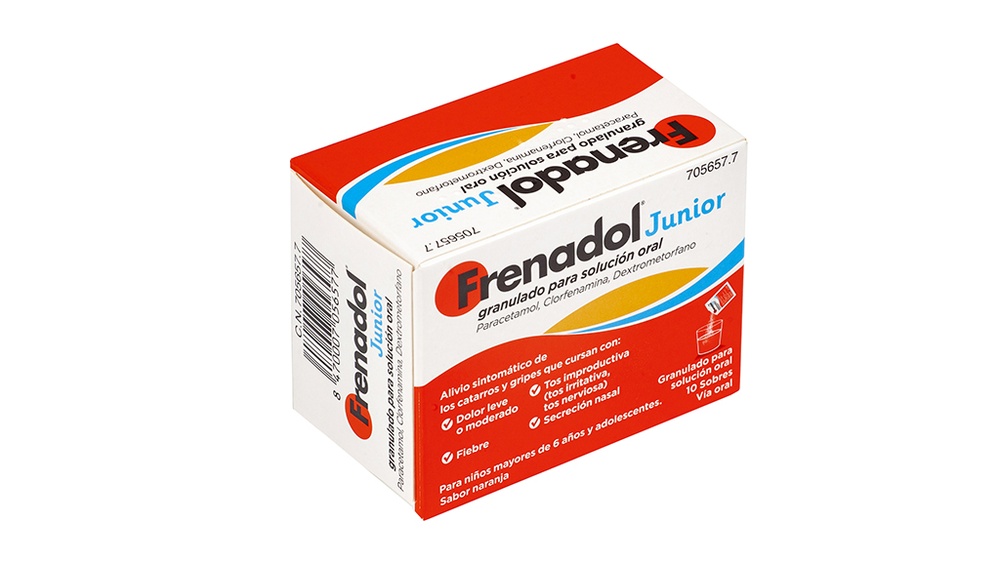

FRENADOL JUNIOR GRANULATED ORAL SOLUTION

Ask a doctor about a prescription for FRENADOL JUNIOR GRANULATED ORAL SOLUTION

How to use FRENADOL JUNIOR GRANULATED ORAL SOLUTION
Introduction
PACKAGE LEAFLET: INFORMATION FOR THE USER
FRENADOL?Junior oral solution granules
Paracetamol/Chlorphenamine/Dextromethorphan
Read all of this leaflet carefully before you start taking this medicine because it contains important information for you.
Follow exactly the administration instructions of the medicine contained in this leaflet or as indicated by your doctor or pharmacist.
- Keep this leaflet, you may need to read it again.
- If you need advice or more information, ask your pharmacist.
- If you experience side effects, consult your doctor or pharmacist, even if it is a side effect not listed in this leaflet. See section 4.
- You should consult your doctor if it worsens or if it does not improve after 3 days.
Contents of the package leaflet:
- What is FRENADOL? Junior and what is it used for.
- What you need to know before taking FRENADOL? Junior.
- How to take FRENADOL? Junior.
- Possible side effects.
- Storage of FRENADOL? Junior.
- Contents of the pack and further information.
1. What is FRENADOL? Junior and what is it used for
FRENADOL? Junior is an association of paracetamol that reduces fever and relieves pain, dextromethorphan which is a cough suppressant and chlorphenamine that helps reduce nasal secretion.
This medicine is indicated for the symptomatic relief of colds and flu that present with mild or moderate pain such as headache, fever, unproductive cough (irritative cough, nervous cough) and nasal secretion for children over 6 years and adolescents.
You should consult your doctor if it worsens, or if symptoms persist after 3 days of treatment.
2. What you need to know before taking FRENADOL? Junior
Do not take FRENADOL?Junior
- If you are allergic to the active substances or to any of the other components of this medicine included in section 6.
- If you have severe liver or kidney disease.
- If you are being treated with a class of medicines called monoamine oxidase inhibitors (MAOIs) or after 2 weeks of having finished treatment with these medicines.
- If you have respiratory failure, asthmatic cough and cough accompanied by expectoration.
- If you are or have recently been treated with other medicines, such as medicines for depression or Parkinson's disease, with linezolid which is an antibiotic or with procarbazine, which is a medicine for cancer (see section “Taking FRENADOL? Junior with other medicines”).
- Children under 6 years of age cannot take this medicine.
Warnings and precautions
- Do not take more than the recommended dose in section 3. How to take FRENADOL?Junior.Taking more than the recommended dose (overdose) can result in liver damage. In case of overdose, seek medical help immediately. Rapid medical attention is critical for adults, as well as for children, even if you do not perceive any signs or symptoms.
- Chronic alcoholics should ask their doctor if they can take paracetamol, other pain relievers or fever-reducing medicines. They should also be careful not to take more than 6 sachets per day (2 g of paracetamol).
- While taking this medicine, you cannot take other medicines that contain paracetamol because a paracetamol overdose could occur, which could damage the liver.
You should consult your doctor or pharmacist before starting to take FRENADOL? Junior:
- Patient with kidney, heart or lung disease and patients with anemia.
- Patient with liver disease (with or without liver failure) or viral hepatitis, as it increases the risk of hepatotoxicity.
- Asthmatic patients sensitive to acetylsalicylic acid.
- Patient sensitive (allergic) to an antihistamine, as they may be sensitive to others (such as chlorphenamine).
- Patient with hypertension (high blood pressure), glaucoma (high eye pressure), hyperthyroidism, obstruction of the vesical neck, prostatic hyperplasia with residual urine formation. Elderly patients who may be more sensitive to the side effects of this medicine.
- Patient with atopic dermatitis.
- Patient with a persistent respiratory condition such as emphysema, chronic bronchitis, bronchial asthma, or cough accompanied by excessive secretions, glaucoma or difficulty urinating due to prostatic hyperplasia.
- Patient who are slow metabolizers of CYP2D6 or who use CYP2D6 inhibitors.
During treatment with FRENADOL? Junior, inform your doctor immediately if:
If you have severe diseases, such as severe renal failure or sepsis (when bacteria and their toxins circulate in the blood, causing damage to organs), or if you have malnutrition, chronic alcoholism or if you are also taking flucloxacillin (an antibiotic). A serious disease called metabolic acidosis (an anomaly in blood and fluids) has been reported in patients in these situations when paracetamol is used at regular doses for a prolonged period or when paracetamol is taken together with flucloxacillin. The symptoms of metabolic acidosis may include: severe breathing difficulties with deep and rapid breathing, drowsiness, feeling unwell (nausea) and vomiting.
This medicine may cause drowsiness. Avoid consuming alcoholic beverages and certain medicines while taking this medicine, as they may enhance this effect. Consult the sections “Taking FRENADOL? Junior with other medicines” and “Taking FRENADOL? Junior with food, beverages and alcohol”.
Sedated, debilitated or bedridden patients should not take this medicine.
In rare cases, severe skin reactions with redness, blisters or rashes can occur. If you notice any of these symptoms, stop treatment and consult your doctor.
Severe skin reactions, such as Generalized Exanthematous Pustulosis (AGEP), Stevens-Johnson Syndrome (SJS), Toxic Epidermal Necrolysis (TEN) and Drug Reaction with Eosinophilia and Systemic Symptoms (DRESS) have been very rarely reported in patients receiving paracetamol. Patients should be informed about the signs of severe skin reactions, and the use of the medicine should be suspended at the first appearance of skin rash or any other sign of hypersensitivity.
Taking FRENADOL?Junior with other medicines
Tell your doctor or pharmacist if you are taking or have recently taken or may need to take any other medicine.
In particular, if you are using any of the following medicines, it may be necessary to modify the dose of some of them or interrupt treatment:
- Medicines to treat epilepsy (lamotrigine, phenytoin or other hydantoins, phenobarbital, methylphenobarbital, primidone).
- Medicines to treat tuberculosis (isoniazid, rifampicin).
- Medicine to prevent blood clots (oral anticoagulants) such as acenocoumarol, warfarin.
- Medicines used to increase urine elimination (loop diuretics such as furosemide, or other diuretics), and other diuretics that cause potassium loss (such as diuretics to treat hypertension or others).
- Medicines used to prevent nausea and vomiting (metoclopramide and domperidone).
- Medicines used to treat gout (probenecid).
- Medicines used to treat high blood pressure (hypertension), such as propranolol, and heart rhythm disorders (cardiac arrhythmias), such as amiodarone or quinidine.
- Medicines to lower cholesterol levels in the blood (cholestyramine).
- Medicines used to treat depression (moclobemide, tranylcypromine, fluoxetine, paroxetine, bupropion), Parkinson's disease (selegiline) or other diseases, such as cancer (procarbazine), infections (linezolid, furazolidone). FRENADOL? Junior should be administered at least 14 days after finishing treatment.
- Other medicines to treat depression, called tricyclic and tetracyclic antidepressants (such as maprotiline).
- Medicines for schizophrenia (such as haloperidol).
- Medicines that cause depression of the central nervous system (such as those used for insomnia or anxiety, for Parkinson's disease, for allergy).
- Ototoxic medicines (which have the adverse effect of damaging the ear).
- Photosensitizing medicines (which have the adverse effect of causing allergy to light).
- Medicines used for pain and inflammation relief (celecoxib, parecoxib, valdecoxib).
- Medicines used to increase mucus secretion.
- Metoprolol, used to treat cardiovascular system diseases (hypertension, acute myocardial infarction).
- Isavuconazole, used to treat invasive aspergillosis and invasive mucormycosis.
- Flucloxacillin (antibiotic), due to a serious risk of alteration of blood and fluids (called metabolic acidosis with high anion gap) that should be treated urgently (see section 2).
Interference with analytical tests:
If you are going to undergo any diagnostic test (including blood tests, urine tests, skin tests that use allergens, etc.), inform your doctor that you are taking/using this medicine, as it may alter the results.
Taking FRENADOL
While taking this medicine, you cannot drink alcoholic beverages, as it may enhance the appearance of adverse effects of this medicine.
Additionally, the use of medicines that contain paracetamol by patients who habitually consume alcohol (3 or more alcoholic beverages: beer, wine, liquor, ... per day) may cause liver damage.
Do not take the medicine with grapefruit or bitter orange juice, as it may enhance the effects of one of its components (dextromethorphan).
Pregnancy and lactation
If you are pregnant or breastfeeding, think you may be pregnant or plan to become pregnant, consult your doctor or pharmacist before using this medicine. The consumption of medicines during pregnancy can be dangerous for the embryo or fetus and should be monitored by your doctor.
This medicine should not be taken during pregnancy unless your doctor considers it strictly necessary.
The 3 active principles of this medicine are excreted in breast milk, so breastfeeding women should not take FRENADOL? Junior.
Driving and using machines
FRENADOL? Junior may cause drowsiness, altering mental and/or physical ability. If you notice these effects, avoid driving vehicles or using machines.
FRENADOL?Junior contains sodium:
This medicine contains 77 mg of sodium (main component of table salt/cooking salt) per sachet. This is equivalent to 3.94% of the maximum recommended daily sodium intake for an adult. Consult your doctor or pharmacist if you need to take one or more sachets per day for a prolonged period, especially if you have been recommended a low-salt diet (sodium).
FRENADOL?Junior contains sucrose:
This medicine contains sucrose. If your doctor has told you that you have an intolerance to certain sugars, consult with them before taking this medicine. Patients with diabetes mellitus should be aware that this medicine contains 4.12 g of sucrose per sachet.
FRENADOL?Junior contains Orange Yellow S (E-110):
This medicine may cause allergic reactions because it contains Orange Yellow S (E-110). It can cause asthma, especially in patients allergic to acetylsalicylic acid.
FRENADOL?Junior contains soybean oil:
This medicine contains soybean oil. It should not be used in case of soy allergy.
3. How to take FRENADOL? Junior
Follow exactly the administration instructions of the medicine contained in this leaflet or as indicated by your doctor or pharmacist. In case of doubt, ask your doctor or pharmacist.
The granules contained in the sachets of FRENADOL? Junior are for oral administration.
The recommended dose is:
Children from 6 to 12 years: (weight between 21.5 kg and 43 kg) 1 sachet every 6 or 8 hours (3 or 4 times a day) as needed.
Over 12 years (weight over 44 kg) 2 sachets every 6 or 8 hours (3 or 4 times a day) as needed.
Preferably take 1 dose before bedtime. Do not exceed 4 doses per day.
This medicine is contraindicated in children under 6 years of age.
Always use the lowest effective dose.
Start treatment when the first symptoms appear and stop as they disappear.
The medication should not be used for more than 3 consecutive days without consulting a doctor. (see section 1. What is FRENADOL? Junior and what is it used for).
How to take:
This medicine is taken orally.
Pour the contents of a sachet into a half glass of water and stir until dissolved.
If you take more FRENADOL?Junior than you should
Go immediately to a medical center, even if you do not have symptoms, as they often do not manifest until 3 days after ingestion of the overdose, even in case of severe poisoning. The most serious effect of an overdose of this medicine is liver damage caused by paracetamol. You may feel dizzy, vomit, confused, excited, restless, nervous, irritable, visual disturbances, loss of appetite, yellowing of the skin and eyes (jaundice), abdominal pain and difficulty breathing. In children, states of drowsiness, or alterations in gait.
There have been cases of abuse with medicines that contain dextromethorphan, which can cause serious side effects, such as agitation, confusion, conversion disorders, hallucinations, ataxia (uncoordinated movements), coma, decreased consciousness, dysarthria (difficulty speaking), apathy, dystonia, nystagmus (involuntary and uncontrolled eye movements), seizures, serotonin syndrome, tremor, depression and central nervous system stimulation, miosis and mydriasis (contraction and dilation of the pupil), respiratory depression, urinary retention, tachycardia, hypertension and ischemic colitis.
The symptoms of an overdose of chlorphenamine may be central nervous system depression, hyperthermia, anticholinergic syndrome (mydriasis, flushing, fever, dry mouth, urinary retention, decreased intestinal sounds), tachycardia, hypotension, hypertension, nausea, vomiting, agitation, confusion, hallucinations, psychosis, seizures or arrhythmias. Patients with prolonged agitation, coma or seizures may rarely develop rhabdomyolysis and renal failure.
Treatment of overdose is most effective if started within 4 hours of ingestion of the medicine. Patients treated with barbiturates or chronic alcoholics may be more susceptible to the toxicity of a paracetamol overdose.
In case of overdose or accidental ingestion, go immediately to a medical center or, if not possible, consult the Toxicology Information Service (telephone: 91 5620420), indicating the medicine and the amount ingested.
4. Possible side effects
Like all medicines, FRENADOL? Junior can cause side effects, although not everyone gets them.
The following side effects were reported in at least 1 in 100 subjects during clinical trials with chlorphenamine: drowsiness, dry mouth, dizziness, restlessness, pharyngitis and dyspepsia.
During the period of use of the association of paracetamol, dextromethorphan and chlorphenamine, the following side effects have been reported, whose frequency cannot be established with precision: anaphylactic reaction, hypersensitivity, insomnia, excitement, nervousness and restlessness (psychomotor hyperactivity), more common in children and the elderly.
Similarly: gastrointestinal disorders, such as abdominal pain, diarrhea, nausea, vomiting and indigestion (dyspepsia), angioedema (swelling of certain areas of the skin), pruritus, urticaria, rash, pruritic rash, skin rash, skin lesions after taking the medicine (fixed drug eruption), as well as increased transaminases.
Frequency not known (cannot be estimated from available data): a serious disease that can make blood more acidic (called metabolic acidosis) in patients with severe disease using paracetamol (see section 2).
Simultaneous consumption of alcohol during treatment may enhance the appearance of side effects. Do not drink alcoholic beverages during treatment.
Reporting of side effects
If you experience any type of side effect, consult your doctor, pharmacist or nurse, even if it is a possible side effect that does not appear in this leaflet. You can also report them directly through the Spanish Pharmacovigilance System for Human Use Medicines. Website: www.notificaram.es
5. Storage of FRENADOL? Junior
Keep this medicine out of the sight and reach of children.
No special storage conditions are required.
Do not use this medicine after the expiration date that appears on the packaging after CAD. The expiration date is the last day of the month indicated.
Medicines should not be disposed of through wastewater or household waste. Deposit the packaging and medicines you no longer need in the Sigre Point of the pharmacy. If in doubt, ask your pharmacist how to dispose of the packaging and medicines you no longer need. This will help protect the environment.
6. Packaging Content and Additional Information
Composition ofFRENADOL?Junior
The active ingredients are: paracetamol 300 mg, dextromethorphan 15 mg (as hydrobromide) and chlorphenamine 2 mg (as maleate).
The other components (excipients) are: sucrose, sodium saccharin, titanium dioxide (E-171), anhydrous citric acid, polysorbate 80, sodium cyclamate, tangerine durarome flavor (contains traces of soybean oil), quinoline yellow (E-104), sunset yellow (E-110).
Appearance of the Product and Packaging Content
Orange-flavored yellow granules for oral solution.
Each package contains 10 sachets.
Marketing Authorization Holder | Manufacturer |
JNTL Consumer Health (Spain), S.L. Pº de las Doce Estrellas, 5-7 28042 Madrid Spain | MCNEIL IBÉRICA S.L.U. Ant. Ctra. N. II, km 32,800 28805 Alcalá de Henares, Madrid Spain |
Date of the Last Revision of this Leaflet:February 2025
Detailed and updated information on this medication is available on the website of the Spanish Agency for Medicines and Health Products (AEMPS) http://www.aemps.gob.es/.
- Country of registration
- Prescription requiredNo
- Manufacturer
- This information is for reference only and does not constitute medical advice. Always consult a licensed doctor before taking any medication. Oladoctor is not responsible for medical decisions based on this content.
- Alternatives to FRENADOL JUNIOR GRANULATED ORAL SOLUTIONDosage form: ORAL SOLUTION/SUSPENSION, 7 mg/mlActive substance: Hederae helicis foliumManufacturer: Engelhard Arzneimittel Gmbh & Co. KgPrescription not requiredDosage form: EFFERVESCENT TABLET, 600 mgActive substance: acetylcysteineManufacturer: Kern Pharma S.L.Prescription not requiredDosage form: EFFERVESCENT TABLET, 600 mgActive substance: acetylcysteineManufacturer: Laboratorios Alter S.A.Prescription required
Online doctors for FRENADOL JUNIOR GRANULATED ORAL SOLUTION
Discuss dosage, side effects, interactions, contraindications, and prescription renewal for FRENADOL JUNIOR GRANULATED ORAL SOLUTION – subject to medical assessment and local rules.














